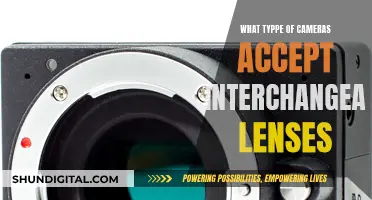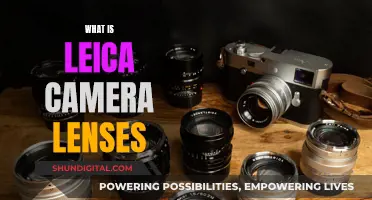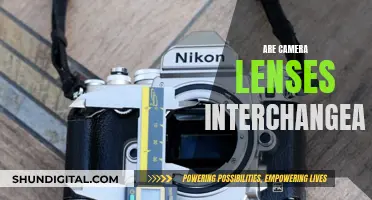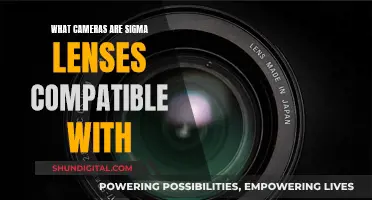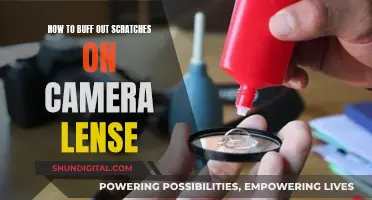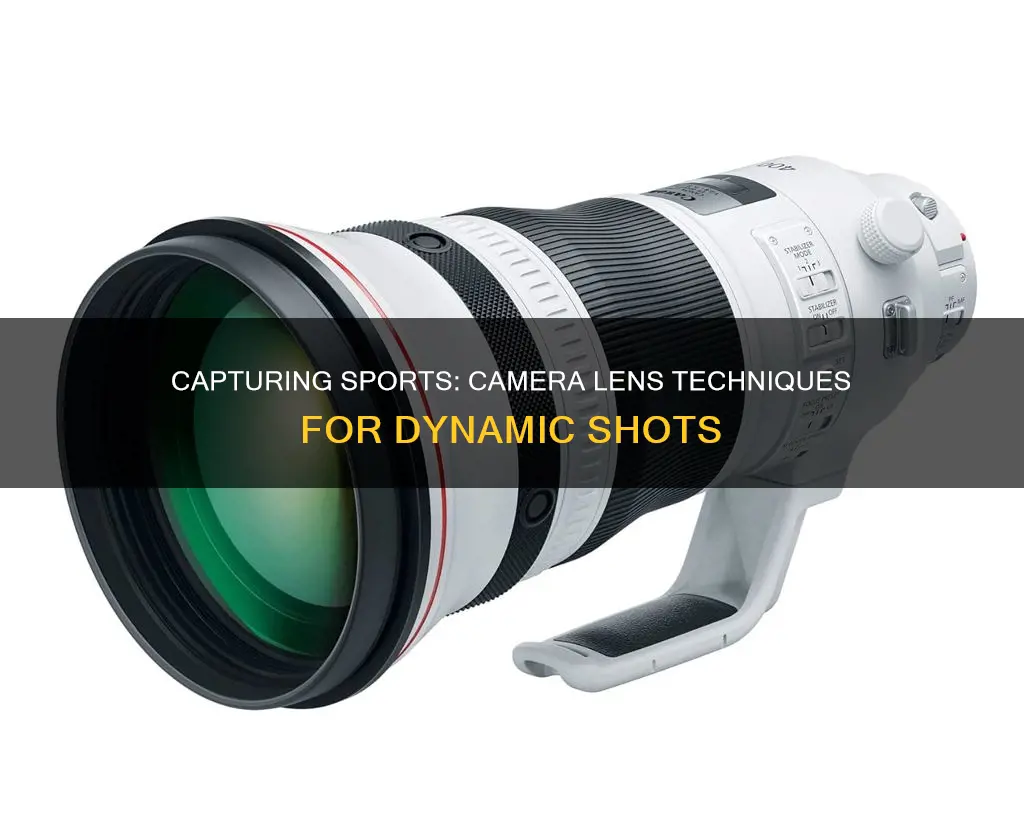
Capturing sports with a camera is challenging but exciting. The key to getting good pictures is to set up your camera properly before the event begins, so you can focus on the action.
A fast shutter speed is essential to freeze motion. Start by putting your camera into Shutter Priority mode and choosing a shutter speed of 1/500 of a second. If you're shooting indoors, you'll need to increase your ISO to compensate for low light.
Use a wide aperture to let in more light and create a shallow depth of field, blurring the background and putting the focus on the main subject.
Sports photography is about capturing the key moments and connecting fans to their favourite teams and athletes. It's important to understand the sport, the rules, and the flow of the game to anticipate the action and be in the right place at the right time.
To get the best shots, experiment with different angles and perspectives, and don't be afraid to get creative with your compositions.
| Characteristics | Values |
|---|---|
| Camera type | DSLR or mirrorless |
| Camera features | Interchangeable lenses, fast continuous shooting speeds, deep buffer, lighting-fast autofocus, high ISO capability |
| Lens type | Wide maximum aperture, fast zoom, telephoto |
| Shutter speed | 1/200s or faster |
| ISO | 1600 or higher |
| File format | RAW |
| Shooting mode | Continuous shooting or burst mode |
| Autofocus | Track-focus function |
| Lighting | Natural light or flash |
What You'll Learn

Camera settings for sports photography
Capturing the perfect moment in sports photography requires the right camera settings to create visually stunning and dynamic images. Here are some essential camera settings to help you capture the energy and excitement of sports:
Shutter Speed
Shutter speed plays a crucial role in sports photography, allowing you to freeze fast-moving action and capture sharp images. A general rule of thumb is to use a shutter speed of 1/1000th of a second or faster for most sports. However, for sports with extremely high speeds, such as motorsports or horse racing, you may need to increase the shutter speed to 1/2000th of a second or higher. It's important to match the shutter speed with the appropriate lens aperture and ISO setting to achieve the desired exposure.
Aperture
The choice between a low f-stop and a high f-stop depends on the desired effect. A low f-stop, like f/1.8 or f/2.8, blurs the background and makes the athlete or action the main focus, creating a dynamic look. On the other hand, a higher f-stop, such as f/16 or f/22, keeps more of the background in focus, providing context to the scene and capturing the atmosphere.
ISO Settings
ISO settings can be adjusted to control the camera's sensitivity to light. In well-lit outdoor conditions, a lower ISO (e.g., 100 or 200) is recommended for cleaner images with minimal noise. However, in low-light indoor environments, a higher ISO (e.g., 800 or 1600) is necessary to maintain fast shutter speeds and capture clear images. Keep in mind that higher ISO settings can introduce more noise into your images.
Autofocus and Burst Mode
Using autofocus mode, such as continuous autofocus (AI Servo or AF-C), helps track moving subjects and adjust focus accordingly. Additionally, burst mode, or continuous shooting mode, allows you to capture multiple images in quick succession, increasing the likelihood of capturing the perfect moment.
Stabilization
Stabilization is crucial, especially when using telephoto lenses, as they tend to introduce more camera shake. A sturdy tripod is ideal for stabilization, but if mobility is required, consider alternative methods like monopods or in-body image stabilization technology.
File Format
Finally, consider the file format—JPEG or RAW. JPEG is a compressed format that is widely used, offers faster processing, and is suitable for quick sharing. On the other hand, RAW captures more data, providing more flexibility in editing but requiring more storage space and time for post-processing.
Remember that mastering camera settings for sports photography takes time and practice. Experiment with different settings and techniques to find what works best for the specific sport and your personal style.
The Ultimate Guide to Cleaning Your Loose Camera Lenses
You may want to see also

Choosing the right lens for sports photography
- Consider the sport you're shooting: Different sports will require different lenses. For example, a 500mm or longer prime lens and a 100-400mm zoom lens would be ideal for football, while a 70-200mm lens might be more suitable for basketball or tennis.
- Think about your distance from the action: You'll likely be a considerable distance from the action, so you'll need a decent amount of telephoto focal range. A zoom lens of up to 400mm can offer more versatility, but longer zoom lenses are often too slow for sports photography.
- Look for fast and sharp autofocus: This is crucial when shooting fast-moving subjects. A fast lens (wide aperture) will help you isolate your subject and improve auto-focus accuracy.
- Consider a blend of zooms and telephoto primes: This is a combination that many professional sports photographers choose. While prime lenses are sharper, zoom lenses offer more flexibility.
- Check your camera type: Different lenses are compatible with different camera types. Make sure the lens you choose is compatible with your camera.
- Don't forget about image stabilization: This can help keep your shots sharp, especially if you're hand-holding your camera.
- Think about your budget: Sports photography lenses can range from a few hundred to several thousand dollars. There are great options at various price points.
Cleaning Camera Lenses: Removing Dust and Maintaining Clarity
You may want to see also

Camera settings for indoor sports photography
Capturing sports events indoors can be challenging due to the fast-paced action, low light, and limited camera movement. Here are some camera settings that will help you take your indoor sports photography to the next level:
- Use a fast camera: Look for a camera with interchangeable lenses (mirrorless or DSLR), fast continuous shooting speeds (at least 8 frames per second, but preferably 10+), a deep buffer for multiple bursts, and lightning-fast autofocus with eye-autofocus tracking.
- Use a wide-aperture lens: A lens with a wide maximum aperture, such as f/2.8, will help you capture more light, resulting in sharper images and lower ISO settings. If you're on a budget, consider lenses with a fixed f/4 maximum aperture.
- Shoot with a fast shutter speed: A fast shutter speed is crucial to freezing the action and preventing blurry images. Start with a shutter speed of at least 1/200s, but faster is better. For very fast sports, you may need to go as high as 1/1000s.
- Balance with a high ISO setting: To compensate for the fast shutter speed, increase your ISO setting to maintain proper exposure. Test your camera at different ISO levels to determine the maximum ISO you can use before noise becomes unacceptable.
- Use RAW file format: RAW files provide more data, allowing for more editing flexibility and higher-quality images. However, JPEGs are smaller, instantly shareable, and allow for longer burst sequences, so choose the format that best suits your needs.
- Perfect your white balance: When shooting indoors under artificial lighting, adjust your white balance to "Fluorescent" or "Tungsten/Incandescent" to avoid colour casts. If you have time, set a custom white balance for the most accurate colours.
- Turn off your flash: In most indoor sports settings, you'll be too far from the action for your flash to be useful, and it may distract the players.
- Use single-point focusing: Switch from multi-point to single-point focusing and use the centre focus point. This will ensure your camera focuses on the subject in the centre of the frame, allowing for faster and more accurate focusing.
- Use Continuous Focusing mode: Instead of "one shot" focusing, use Continuous Focusing mode (AI Servo on Canon cameras) to keep the subject in focus even when it's moving.
With these settings in mind, you'll be well on your way to capturing stunning indoor sports photographs. Remember to practice, get to know your gear, and anticipate the action to make the most of these camera settings.
The Camera Power of the Note 9
You may want to see also

Camera settings for outdoor sports photography
Capturing the fast-paced action of sports events can be challenging, but with the right camera settings, you can get sharp and dramatic shots. Here are some essential settings to consider for outdoor sports photography:
- Shutter Speed: Shutter speed is critical in sports photography. A fast shutter speed is necessary to freeze the action and prevent blurry images. Set your camera to Shutter Priority mode and choose a shutter speed of at least 1/500 of a second. For very fast sports, you may need to go as high as 1/1000 of a second.
- Aperture: A wide aperture, such as f/2.8, is ideal for sports photography as it lets in more light and creates a shallow depth of field, blurring the background and focusing on the players. However, if you're using a zoom lens, set your lens around the middle of its range to balance filling the frame and letting in enough light.
- ISO: Keep your ISO as low as possible to minimize digital noise. In outdoor sports with sunny weather, an ISO of 100-200 is sufficient. However, in low-light conditions or indoor events, you may need to increase the ISO to 800 or higher.
- Autofocus Mode: Select Servo AF (Canon) or AF-C (Nikon and Sony) to continuously focus on your chosen subject. Modern mirrorless cameras also offer AF Tracking, head/face detection, and eye-detection modes, which are excellent for focusing on athletes in busy environments.
- Focus Mode: Use single-point focusing and select the focus point at the centre of the frame. This ensures that your camera focuses on the subject in the centre, rather than trying to keep everything in focus.
- Shooting Mode: Use Continuous Focusing mode ("AI Servo" on Canon) to keep the subject in focus at all times.
- White Balance: For outdoor sports, your camera's automatic white balance usually works well. However, for indoor sports under artificial lighting, manually set your white balance to Fluorescent or Tungsten/Incandescent to avoid colour casts.
- Image Stabilization: While not necessary when using fast shutter speeds, image stabilization can be helpful in low-light conditions or when using a telephoto lens, allowing you to use slower shutter speeds without blurring.
- File Format: Consider shooting in JPEG format instead of RAW. JPEG files are smaller, allowing you to capture more images and not miss any crucial moments. They are also more widely compatible and easier to transfer to other devices.
Minolta Lenses: Universal Fit for Minolta Cameras?
You may want to see also

Best cameras for sports photography
When it comes to sports photography, you'll want to look for a camera with fast burst shooting, fast autofocus, and fast memory.
Best all-round camera for sports photography:
The Canon EOS R5 Mark II is a great all-rounder. It has the most reliable autofocus, the best stabilization, in-camera AI features, and can even shoot 8K.
Best camera for pure speed:
The Sony A9 III has a blistering burst rate of 120fps.
Best camera for sports videography:
The Nikon Z8 has a smaller, more rig-friendly form factor and a slew of options and great record times.
Best cheap camera for sports photography:
The Canon EOS R10 is a great option for beginners. It has a flagship autofocus system and, with the mechanical shutter, it's faster than the R3 and the Sony A1.
Best DSLR camera for sports photography:
The Canon EOS-1D X Mark III is a robust DSLR with an incredible autofocus system, rapid-fire bursts, and an optical viewfinder.
Best Sony camera for sports photography:
The Sony A9 III is an absolute monster. It has raw speed, a global shutter sensor, and a dedicated AI processor to power its predictive autofocus system.
Best mirrorless camera for sports photography:
The Nikon Z 70-200mm f/2.8 VR S is a superb lens for Nikon’s mirrorless camera range. It has a fast f/2.8 maximum aperture, built-in optical vibration reduction, and a custom control ring and function button.
Best lens for sports photography:
The Canon EF 70-200mm f/2.8L IS III USM is a versatile lens with a fast lens, image stabilization, and a zoom range to get you close to the action.
Best bridge camera for sports photography:
The Sony Cyber-shot RX10 IV is a great option for the amateur photographer who wants a camera with wildlife or sports capabilities without spending a fortune. It has a 24-600mm lens and 24 FPS.
Cleaning Camera Lenses: A Step-by-Step Guide
You may want to see also
Frequently asked questions
The Canon EF 70-200mm f/2.8L IS III USM is a great option for sports photography as it has a fast lens, image stabilization, and a zoom range to get you close to the action.
It is recommended to use a fast shutter speed of at least 1/200s to freeze the action and capture sharp photos. A wide aperture, such as f/2.8, is also ideal to let in more light and create a shallow depth of field. Additionally, using a high ISO of at least 1600 will help compensate for the fast shutter speed and maintain proper exposure.
A fast camera with interchangeable lenses, such as a mirrorless camera or a DSLR, is ideal for sports photography. Look for cameras with fast continuous shooting speeds (at least 8 frames per second), a deep buffer, and lighting-fast autofocus with eye autofocus tracking.


